Laminate - material based on high-density fiberboard. A wear-resistant film is used as the top layer, which performs decorative and protective functions.
Initially, the laminate was, but thanks to the use of various fastening structures, the walls and ceiling began to be finished with a laminate. If flooring with this material does not cause any particular difficulties, then wall cladding requires additional devices and labor costs.
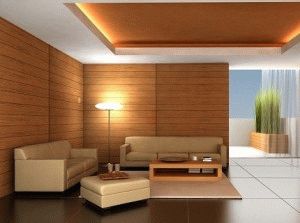
The laminate is divided into adhesive, tongue and groove.
- Adhesive The laminate is characterized by smooth edges without a lock to connect the panels. It is attached to the surface to be trimmed with building silicone or liquid nails. For special adhesives are produced. The panels are also glued together.
- sheet piling The laminate for joining the panels has a tongue and groove lock. The parts of the coating are joined without the use of glue. The strips are fastened with small nails through the tongue groove to the wooden crate. Special brackets (clamps) are also used for styling. With their help, you can mount the material both on metal and on. This type of laminate is suitable for wall, ceiling and floor cladding.
- clicky The laminate is mounted according to the sheet pile principle, but its lock has an improved design. The profile of the ridge of the lock, like the groove, has pear-shaped. When laying, the comb is inserted into the groove at an angle of 20°, rotated towards the surface to be trimmed, then pressed. The panel lock snaps into place. The material is attached to the wooden crate with glue, carnations are additionally hammered into the groove of the lock. Clamps are not used, since the lock in this case will not snap into place.
The choice of type of laminate for wall sheathing depends on the way in which you are going to fix the flooring. Laying adhesive material saves space, but requires more thorough preparation of the base. Tongue and click types of panels are easy to install and hold on to the wall more firmly.
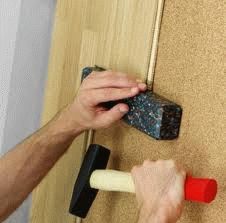 For wall cladding with laminate panels other than conventional specific used when installing a floor covering made of this material:
For wall cladding with laminate panels other than conventional specific used when installing a floor covering made of this material:
- Boss. Using a boss and a hammer, when laying the laminate, they knock out strips for sealing.
- Rule. With this tool, the last strips are fixed by tapping with a hammer or hand on the “flag”.
- Expanding wedges. Used to control the indentation around the perimeter.
Installation of laminate on the walls
More often, the walls of the hallways are trimmed with laminate, sheathing them completely or in half (along the height of one plank). In living rooms, they cover a certain part of the wall, for example, behind the TV. They decorate the area at the head of the bed, in the kitchens they allocate a dining area. The material is also used for finishing ceilings.
Finishing the kitchen with laminate is not recommended. Fiberboard and chipboard do not undergo complex processing during production. Therefore, the material is subject to deformation when exposed to humidity and temperature changes. In the kitchen, the changes in these parameters are sharp and significant.
For the same reasons, such finishing should not be carried out for closets, cellars, and balconies. In these cases, it is better to use plastic lining, MDF or eurolining.
So that after installation the laminate does not deform over time, it must be kept for several days in the room where it is to be laid. The material adapts to the temperature and humidity of the room and will not change its shape afterwards.
The walls are sheathed with laminate in two ways - glue and frame. An adhesive type of material is attached to the adhesive accordingly. For tongue and groove, you can use liquid nails and special fasteners.
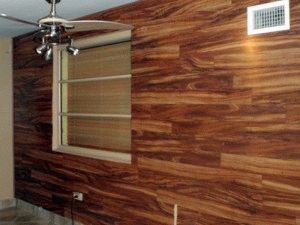 The adhesive method requires careful preparation of the wall surface. It is the application of starting plaster or the installation of drywall sheets. To create a flat surface, the wall can be sheathed with plywood or OSB sheets, after installing the crate.
The adhesive method requires careful preparation of the wall surface. It is the application of starting plaster or the installation of drywall sheets. To create a flat surface, the wall can be sheathed with plywood or OSB sheets, after installing the crate.
Irregularities no more than 1-3 mm are allowed. The surface must be primed. Marking is applied to the prepared wall. The surface is beaten off with lines vertically and horizontally for control when laying panels.
To fix the panels on the back surface, construction glue or liquid nails are applied. selected depending on the type of surface. The laminate is fixed one by one and in stripes. In the second case, when docking, it is necessary to lift the previous strip to engage the interlock. Therefore, laying must occur fairly quickly so that the glue does not have time to dry. There is a method in which the elements are docked on the floor into panel blocks.
Installing laminate flooring
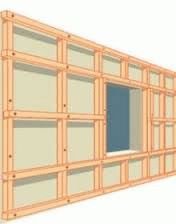 The crate is made of wooden bars 30 x 30 mm or 40 x 40 mm. Holes ø 6 mm are drilled in the bars. Strictly vertically installed bars are used as guides. Holes are drilled through them in the wall. Plastic dowels are inserted into the holes, and parts of the crate are attached using self-tapping screws (no more than 70 mm).
The crate is made of wooden bars 30 x 30 mm or 40 x 40 mm. Holes ø 6 mm are drilled in the bars. Strictly vertically installed bars are used as guides. Holes are drilled through them in the wall. Plastic dowels are inserted into the holes, and parts of the crate are attached using self-tapping screws (no more than 70 mm).
Dowel-nails are also used. The cross slot on the nail allows you to unscrew it from the dowel if you need to dismantle it. The step of the lathing is determined by the dimensions of the panels and must create sufficient rigidity.
The panels are fastened with clamps, which are also used when mounting MDF panels. Klyammer sits on the edge of the groove from the side of the wall. The strip is pressed against the crate, and the fastener is nailed to it. The plate, despite its small thickness, can interfere with the insertion of the ridge into the groove. In this case, the section of the ridge above the clamp is carefully broken off with pliers.
Planks are often fixed in a checkerboard pattern. Laying is done clockwise, starting from the left wall. Gaps are left along the edges of the coating in case of expansion of the material of construction. They are closed with special overlays.
Sound and heat insulating materials are sometimes laid between the wall and the panels. Apply sheets of polyurethane foam, mineral wool etc.
- Are you planning to install laminate flooring? In this case, our about leveling the floor under the laminate will be useful to you.
- Performing the installation interior doors independently, it is important to strictly adhere to a certain sequence of actions. You can avoid mistakes by reading ours.
- Laminate for the kitchen is subject to increased requirements for wear resistance and water resistance. You will receive advice on choosing the right laminate for your kitchen.
A popular method of finishing walls with laminate - Wall&Water.The material is placed on the aluminum frame using silicone and click joints.. The joints are carefully coated with silicone, the extruded sealant is cleaned off, and the structure acquires an increased density.
This can be used for rooms with high humidity.. A gap is left along the lower edge of the structure near the floor. An aluminum profile is inserted into it and closed with a plinth. This detail will avoid rotting of the coating and extend its life.
 When laying laminate at the doors of the room, the platbands are pre-removed and re-mounted upon completion of the finish. Fasteners designed for MDF panels are suitable for installing laminate.
When laying laminate at the doors of the room, the platbands are pre-removed and re-mounted upon completion of the finish. Fasteners designed for MDF panels are suitable for installing laminate.
Distinctive qualities of a laminate - increased impact resistance compared to other wood materials, resistance to household chemicals, high degree of fire safety, abrasion resistance. In the technology of laying laminate panels, there are no complex operations that do not allow you to carry out the installation yourself. A variety of types, colors and textures of the material allows you to realize any ideas for decorating the walls "under the tree".
The popularity of laminate as an aesthetic and inexpensive material for flooring is beyond doubt.
Simple installation, minimum preparation and excellent results - these qualities of laminated coatings brought them to the first places in the rating of developers' sympathies.
More recently, designers have switched to using laminate panels for interior wall decoration.
The result was quite predictable - the excellent texture of the material, the rich color palette was to the taste of the customers.
Of course, finishing the walls with a continuous laminate is a pointless exercise. Who likes a floor that blends into walls even with different texture patterns? But as inserts, accents, wall decoration with laminate is beyond competition. Any interior style from classic to high-tech can be advantageously supplemented in a similar way.
It is appropriate in rooms for various purposes: bedroom, hallway, bathroom, living room, loggia and kitchen. In each case, this material requires a harmonious combination with the main color scheme of the finish.
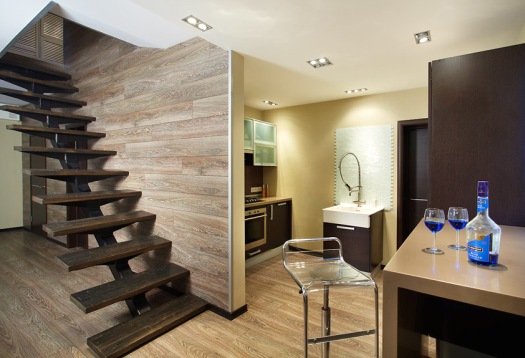
Consider the most successful options for interior decoration of premises with laminate panels.
Laminate on the walls in the general context of the interior
The soft and warm texture of wood is ideal for a hallway. If finishing the floor with a laminate here no longer surprises anyone, then laminated wood-like panels on the walls will look fresh and original.
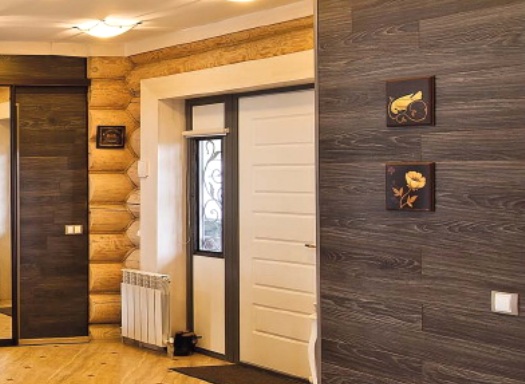
Laying laminate on the wall is easy to perform and is a great option for a bedroom. The color tone of the wall decoration behind the bed in this case is better to choose less intense than that of the floor covering.
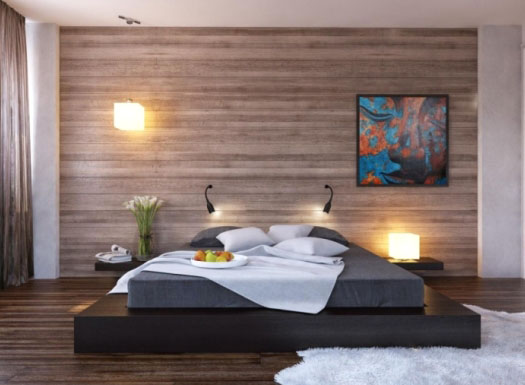

In the kitchen, a beautiful and hygienic wall covering with laminate will be logical and practical. If the room is finished in light colors, then it is better to make the laminate insert on the wall dark and contrasting.
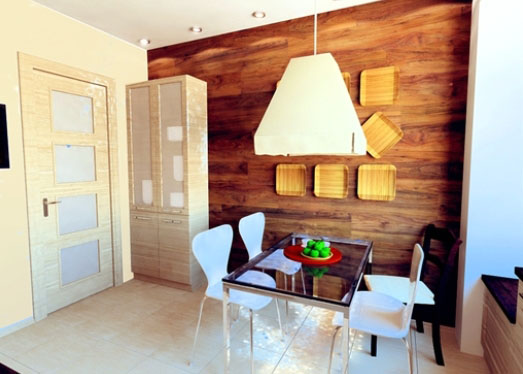
As protective screen the working surface of the laminate is not inferior ceramic tiles- classic material in the interior decoration of the kitchen.
The design of the living room with inserts of laminated panels or a solid finish on one of the walls is an interesting and modern solution.
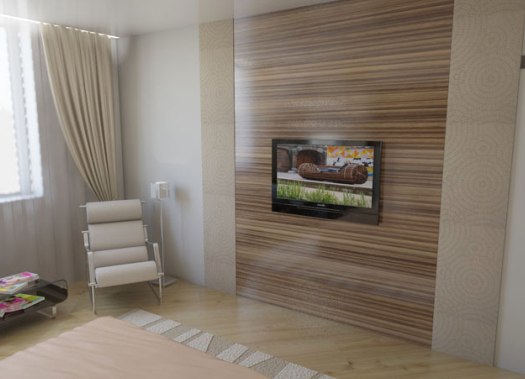
Do not forget that in addition to harmony colors cladding, you need to take into account the direction in which the installation of the laminate on the wall will be performed. Horizontal installation of slats visually reduces the height of the ceiling, so it is appropriate for high living rooms. Vertical, on the contrary, makes the room higher, therefore it is justified in small apartments.
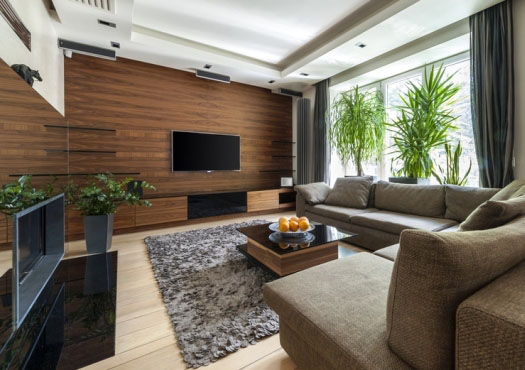
The resistance of the laminate to moisture allows it to be used in the decoration of the bathroom.
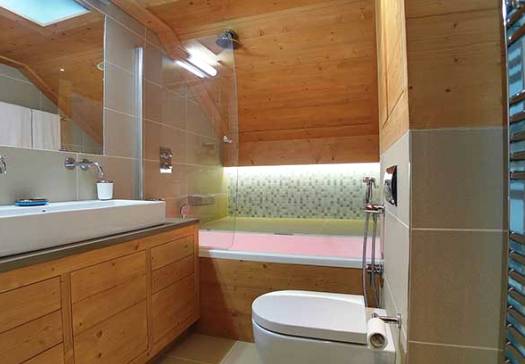
However, do not abuse this positive quality of coverage. Efficient ventilation is a prerequisite for the durability of the laminated surface in the bathroom.
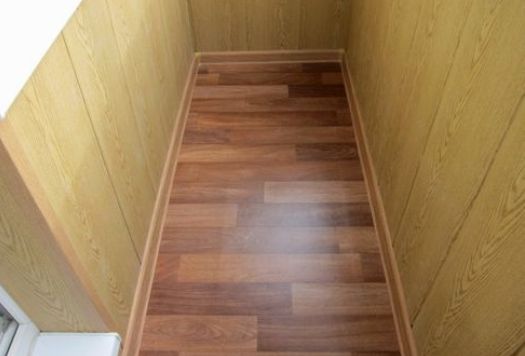
Finishing a balcony or loggia with a laminate is a very popular application for this material. Here it is placed to protect the wall insulation from high humidity, as well as facing home-made stationary furniture (lockers and cabinets).
How to put laminate on the wall yourself?
We will sin against the truth if we claim that it is easy and simple to put a laminate on a wall. Big square strips and ease of their joining - positive points this work. However, without high-quality surface preparation and strict adherence to technology, the finishing result will be lower than you expected.
Laminate wall cladding can be made in two versions:
- on the frame;
- on glue.
The technology of cladding with laminate on the frame is different from laying the flooring.
The order of work (vertical installation of slats) is as follows:
- We mark the wall for the installation of the frame;
- We cut the frame bars with an electric jigsaw in accordance with the calculation;
- We fix the level of vertical bars to the wall;
- At the bottom of the wall, in the middle and on top, we horizontally fasten three bars;
- We fasten steel brackets-holders to the horizontal bars of the crate for mounting the first laminate lamella.
- We leave an air gap between the lower and upper ends of the lamellas, the floor and the ceiling. After installation is completed, it is closed with a decorative aluminum profile.
- We put the panels one after the other (we insert the spike of the mounted lamella into the groove of the installed one);
- Every installed panel we also fix it to the frame with a holder bracket;
- Joints during installation must be insulated with silicone sealant, applying it to the crest of the inserted lamella.
The space that is formed between the laminated board and the wall can be filled with insulation, increasing the level of energy saving of the walls.
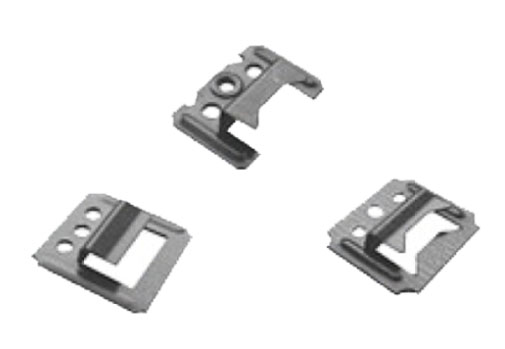
After completing the installation of the laminate, the edges of the cladding must be closed with aluminum or plastic corners, applying a layer of sealant to them.
Glue mounting
Answering the question of how to fix the laminate on the walls, you need to talk about adhesive installation. It significantly saves the usable space of the room, but requires careful alignment of the walls.
The lamella shield is completely assembled on the floor. Then it is lifted and pasted on the wall. For fastening, you can use any high-quality water-dispersion glue (for wood). The joints in this case should also be smeared with sealant, and the edges should be covered with a decorative corner.
It should be noted that adhesive mounting is best used for facing small surfaces, since it is very difficult to install a not very rigid laminate shield with an area of 10 - 15 m2 on the wall.
When decorating your apartment or house, you always want to make everything beautiful, exquisite, unique and, most importantly, tasteful. But at the same time, practical, beautiful, modern materials for finishing. The main thing is to decorate the walls in an original way. For walls, wallpaper, paint or special finishing putty are usually used, but in recent times wall decoration with laminate has become popular. A photo of a design of such a design can be seen in the selection. Such a finish will allow for a long time to preserve the aesthetic appearance of the surface, at the same time protect them from the negative impact, from deformation, destruction. But before proceeding with the installation of this material, it is worth considering its main features, varieties and other important nuances.
For interior decoration different types of laminate can be used, which can differ in many characteristics.
According to the installation method
This type contains the following types of material:
- adhesive;
- sheet piling;
- click.
The first type of laminate is installed on the wall through the use of special glue. The installation of these products is quite easy. However, if you use a low-quality adhesive base, over time, the material may fall off the wall. They have a beautiful variety of external texture.
AdhesiveThe grooved and click type is installed using a locking mount. The latter option has an additional adhesive mixture, which provides fastening strength.
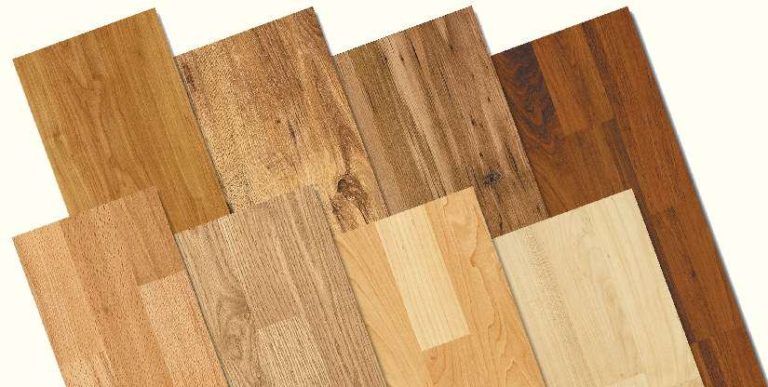 clicky
clicky 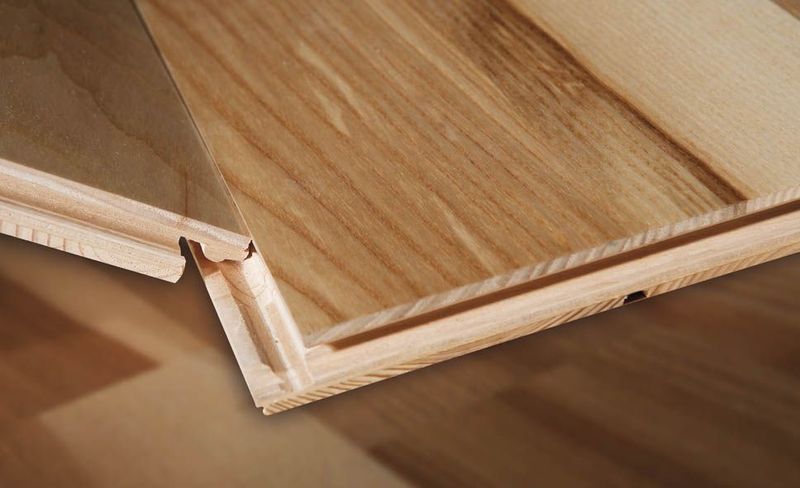 sheet piling
sheet piling By type of coating
To finish the wall surfaces of the hallway, kitchen, toilet, bathroom, bedroom, living room, you can use a laminate with a different texture of the coating. The most common materials, depending on the external coating, include the following types of laminate:
- MDF panels - this material is different acceptable cost and fairly easy to install. The surface of the base of this material looks like varnished paper. These panels are recommended to finish the dining area of the kitchen;
- Chipboard - for laminated boards of this type, it is not necessary to install a crate, which is designed to create additional strength of the material after its installation. These plates have high strength, wear resistance;
- Laminated hardboard is a pressed type material with high strength. It is often used to decorate an apron in the kitchen;
- laminate flooring is the simplest material that is used for wall decoration in the hallway, kitchen, bathroom and toilet.
 chipboard
chipboard 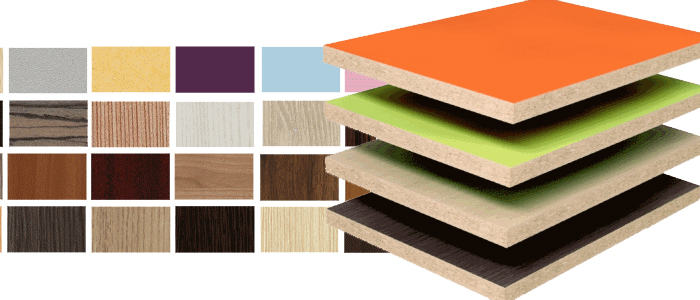 MDF
MDF 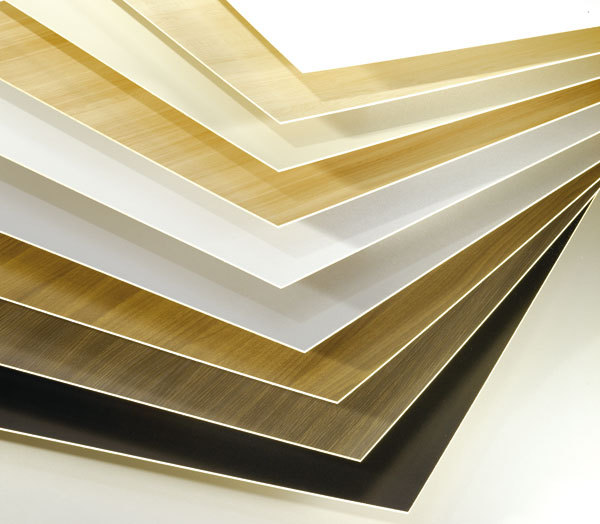 Laminated hardboard
Laminated hardboard 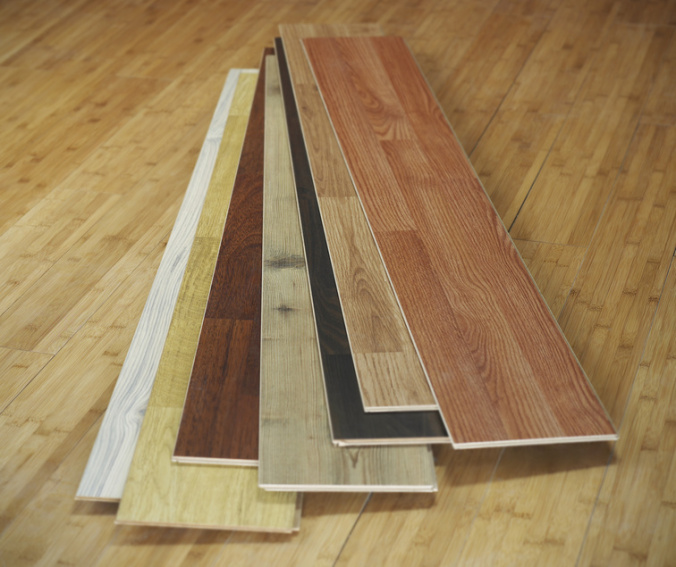 Floor
Floor Depending on strength class
The classification of laminate depending on the strength class is determined according to the European standard EN 13329, according to which the strength of the material is checked by 18 of its parameters. For wall cladding in the hallway, kitchen, bathroom and toilets, material with a strength class of 21 to 31 is suitable. This class includes a material that does not have high strength indicators.
The material of this class can have a wide variety of textures, color solutions, drawings. Additionally, you can see photos that will make it much easier to choose a plate. You can choose panels with an external texture that imitates natural material, wood, stone, grass and others.
 Laminate strength class
Laminate strength class Wall finishing technology
If you decide to glue the walls in your apartment or house, then you definitely need to know all the technology for carrying out these works. It is advisable to first see the photo with the methods of installing this material, and you can also see the installation technology of these plates on them.
Required Tools
Laminate finishing includes the necessary tools:
- jigsaw for cutting panels. It is advisable to purchase a quality tool, because in the future it will be required for other repairs. In addition to the tool, you should buy consumables, namely files;
- hammer for adjusting the plates. To install the panels on the walls, it is enough to have a hammer weighing no more than 500 grams;
- ruler and square - these tools should not be too long. Suitable size is about 35 cm;
- roulette - for sure this tool can be found in every home, so you don’t have to buy it;
- a simple pencil for marking notes;
- a bar for tamping - it will be suitable from a plastic base;
- wedges for limiting - these elements are needed to fit and indent the required gap from the wall surface;
- a special bracket, which is designed for padding panels;
- other additional tools - angle cutter, puncher, hacksaw, drill.
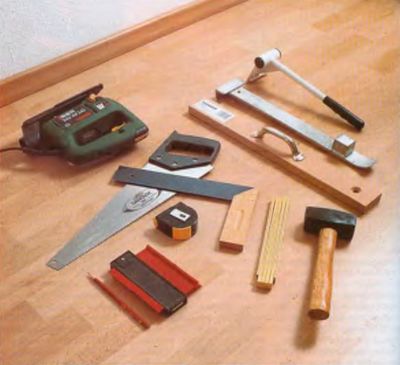 Tools for the job
Tools for the job Preparatory work
After the tool is prepared, you need to prepare the surface of the wall on which you plan to install the panels. It is prepared as follows:
- if there is a coating of wallpaper or paint on the wall, then everything must be removed. To do this, you can use a spatula;
- if there is paint on the surface of the wall, then it can be removed with a puncher, for this a special nozzle is used;
- after that, the surface is checked for the presence of various irregularities. If they are, then they should be covered with putty;
- after that, everything is rubbed with sandpaper.
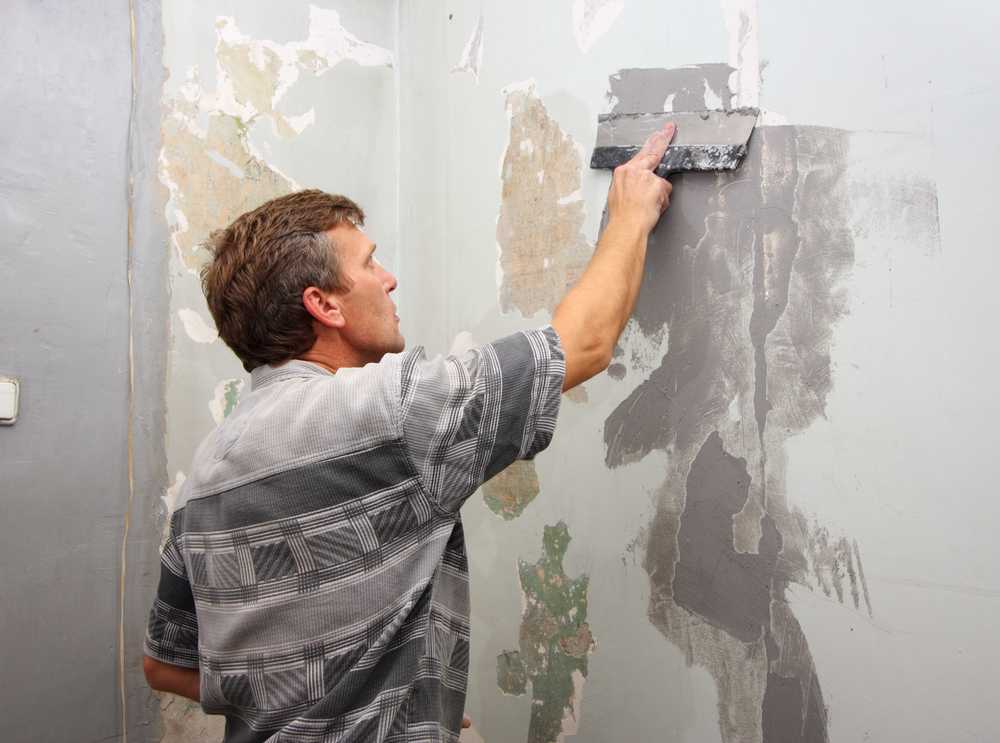 Surface preparation
Surface preparation In addition to preparing the walls, you need to decide how the panels will be laid - horizontally or vertically. This you must decide for yourself. After that, you can start laying the laminate. As it was written above, depending on the fastening, it can be installed in several ways - glue, sheet pile and blade.
Adhesive
Adhesive laminate is easy to install. This material is often used for flooring. different rooms apartments, houses. Features of installing adhesive laminate:
- since panels of this type have smooth edges without locks, it is installed using an adhesive mixture - liquid nails, silicone;
- glue is applied to the wrong side, a strip is laid, glue is again applied to the end and the next panel is laid again, and so on the rest of the panels are laid;
- if there are currents of glue, they should be removed with a piece of cloth, which is pre-moistened with vinegar;
- this material is installed without a crate.
 A layer of adhesive must be applied to the surface of the wall
A layer of adhesive must be applied to the surface of the wall 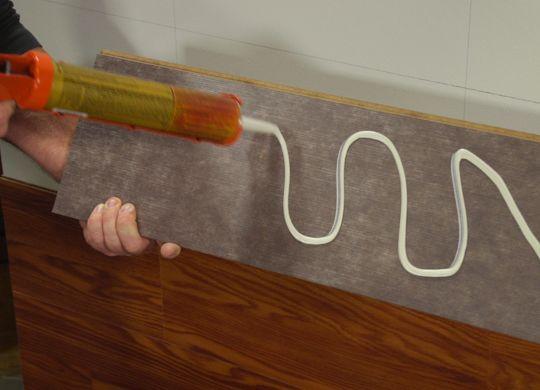 Applying adhesive to laminate panels
Applying adhesive to laminate panels  Material laying
Material laying sheet piling
Sheet pile laminate is often used to decorate the walls of different rooms. Since this type of panels are equipped with special locks, no adhesive mixture is required for their installation. Features of sheet piling installation:
- panels of this type are installed dry, while there must be a crate;
- strips must be attached to the grooves of the tongue;
- the fastening of these panels is similar to lining, in which nails and staples are used.
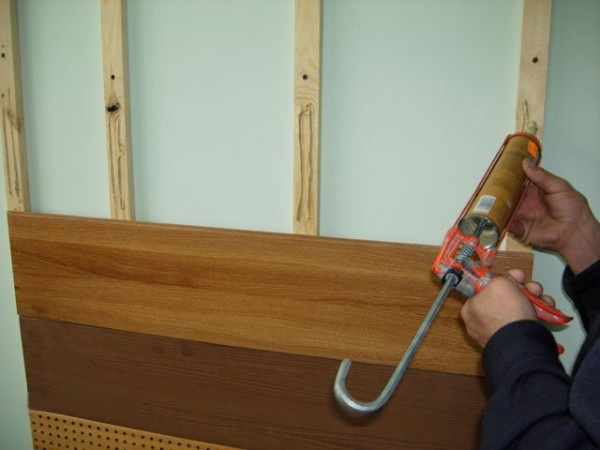 Laying laminate flooring
Laying laminate flooring 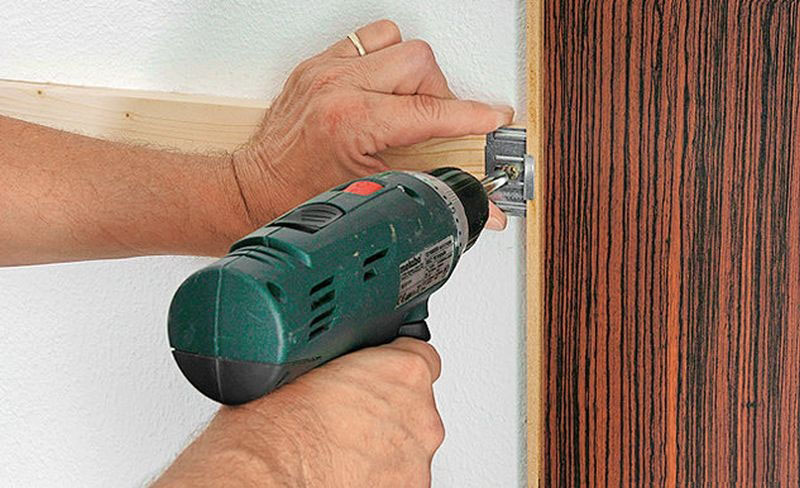 Fastening sheet piling with clamps
Fastening sheet piling with clamps clicky
This type of material is a more advanced material for interior decoration. It is installed in a double way - lock and glue. It has high strength, it can even be laid on the crate. Is it worth talking about the wear resistance of these panels? Unlike the above types of laminate, this type has high strength, resistant wear.
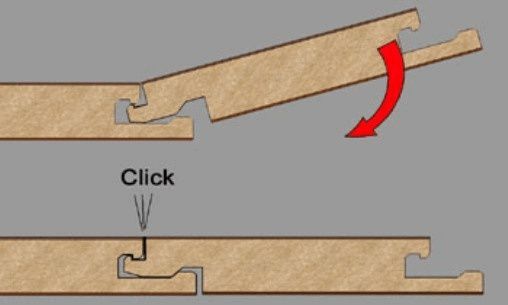 Fastening click laminate boards to each other
Fastening click laminate boards to each other Laminate in design
Depending on the purpose of the room, the laminate can be used to design a particular area.
Hallway
Laminate is an excellent material for wall decoration in the hallway. With it, you can easily replace the old coating, which has lost its appearance, has become old, pale. It can be installed in the hallway either on the entire surface of the wall or on a panel type, when the lower part is finished with a laminate with a wood-like texture, and the upper part is finished with wallpaper in lighter colors. Do not forget to look at the photo with wall decoration options in this particular room.
Kitchen
Laminate panels can be successfully used for finishing kitchen walls. Since this material has a different texture, surface, you can easily find a material that can replace tiles, cork, marble and granite type coatings, wood. Many photos show how laminate can transform the style of this room.
For the kitchen, you should choose a material with high class strength, which can easily endure the effects of moisture, not be damaged, withstand mechanical stress.
Living room
If you have not yet thought about finishing the design of the living room with laminate, then it's time to think. This material is the most suitable for decorating walls in guest rooms. The main thing in this matter is to choose the right color and texture of the panel pattern. Of course, the laminate that is used for kitchens or hallways will look out of place here. If the style of the living room is strict, then the panels should fit exactly into this type of style. Often it is installed in the area above the TV or below the windowsill.
Bedroom
Laminate can be used to decorate the walls in the bedroom. It can replace wood flooring, which usually requires a large investment.
Features of the choice of material for the bedroom:
- a laminate with a texture like a wooden material will give the room a more respectable, rich appearance;
- for the bedroom, you can use panels with various patterns in the form of flowers or patterns. You can preview photos from various types these panels;
- tones should be chosen more gentle, soft, giving comfort and warmth to the room.
Balconies and loggias
Laminate is a practical material that can protect walls from various negative influences, so it is often used to decorate balconies and loggias.
Benefits of finishing laminate balconies, loggias:
- beautiful, aesthetic appearance;
- closing of all cracks;
- protection of walls from negative impact;
- long service life of the coating. Typically, the coating can last over 15 years.
![]()
The use of laminate as a floor covering is a familiar solution that is actively used for the design of both residential and public buildings.
This material is extremely practical and durable, it looks great and easily becomes part of the interior in any style.

Recently, it has been actively used to decorate the surface of walls. It adds a special naturalness and organicity to the room.
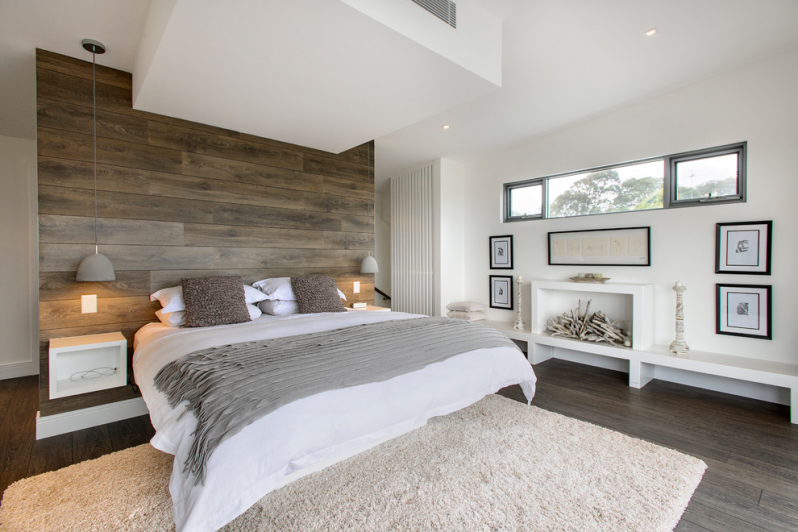
Laminate on the wall in the interior modern apartment, as will be seen in the photo, it looks expensive and elegant.
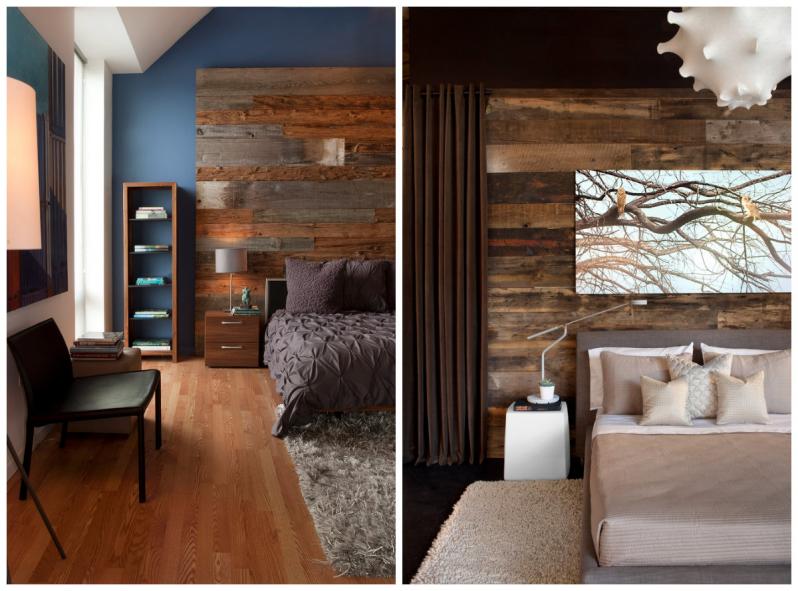
In reality, it is even more interesting and noble, especially if it is correctly combined with other materials and textures.
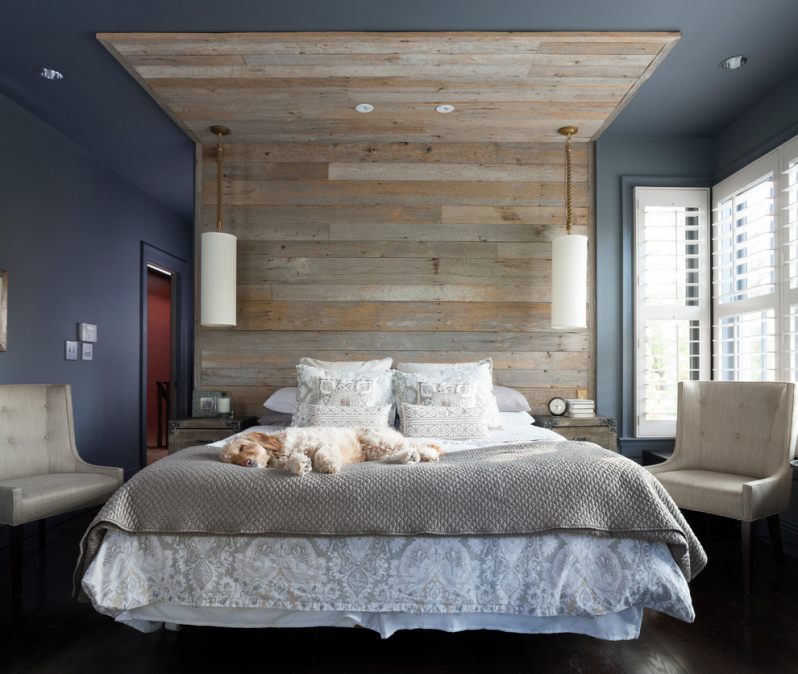
Among key benefits this building element can be distinguished:
- available antistatic properties;
- resistance to direct sunlight;
- hygiene;
- wear resistance - the average service life (on the floor) is 10-15 years;
- ease of care;
- safety for human health and domestic animals;
- excellent protection against mechanical (impact, scratches, cracks) damage;
- abrasive resistance chemical compounds etc.
Horizontal placement of laminate on the wall
When installing the laminate parallel to the floor, you can visually make the space more elongated, airy and free. Especially if you add it with stylish "patches" of ordinary or matte mirrors.

Traditionally, for large rooms, larger canvases are chosen, and for small rooms- miniature neat stripes.

Although many designers defy this rule and fill the wall of a nine-meter room with several huge panels.

By the way, the combination of laminated boards of several contrasting shades looks very bright. For example, walnut, chocolate and beige; pearl, white and platinum.

Lamellas can be placed one under the other or they can be laid out in an intricate mosaic. It all depends on your preferences and the features of the decorated room.
![]()
They can be the same length or completely different, but it is better to choose them that are similar in thickness. Otherwise, the pattern will shift and lose its harmony.
We place the laminate on the wall vertically
Vertical installation of laminate profiles makes ceilings appear higher. Especially if the tone of the boards matches the color of the floor design. In the case of similarity with the tone of the ceiling decor, this effect disappears.
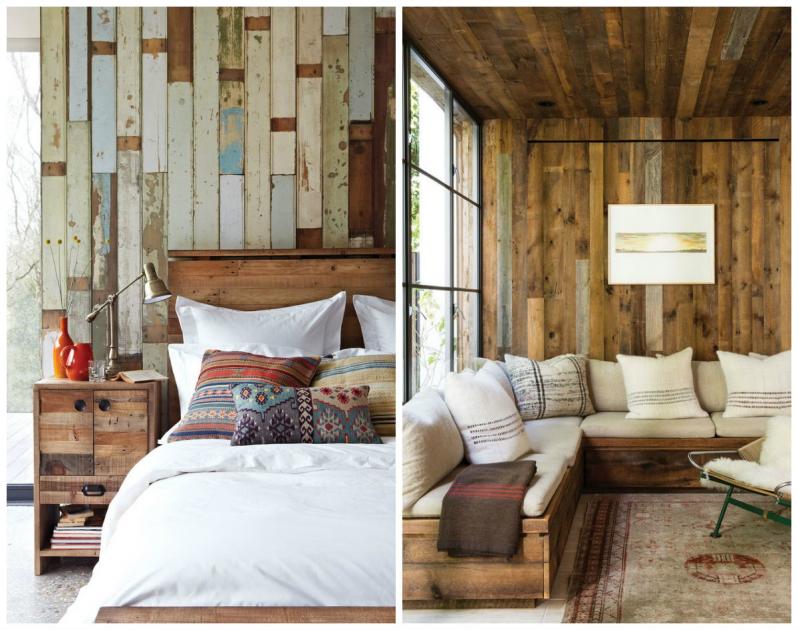
The smaller the stripes and the pattern itself on them, the more expressive and complex the room seems, regardless of the lighting and the amount of furniture.
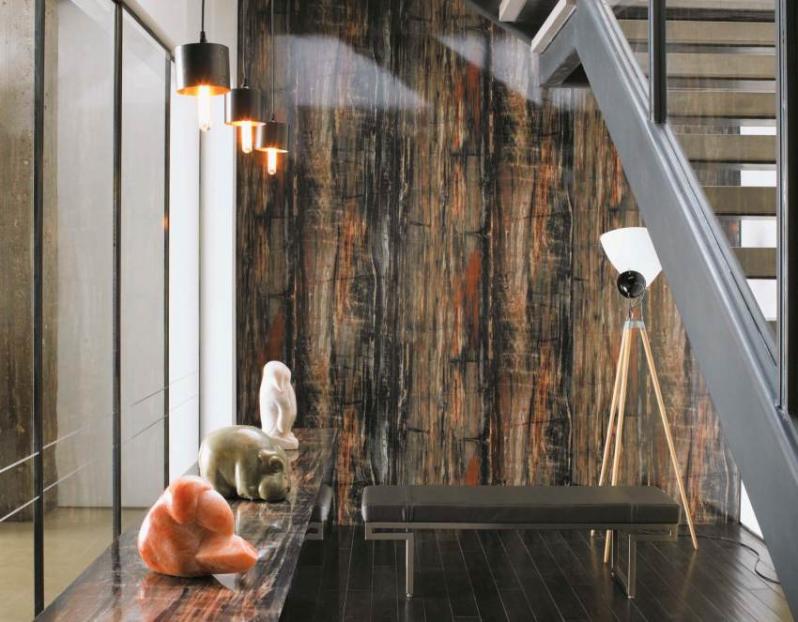
It is best to choose a wall that is opposite the window. Natural lighting will focus on it and make it more noticeable and catchy.
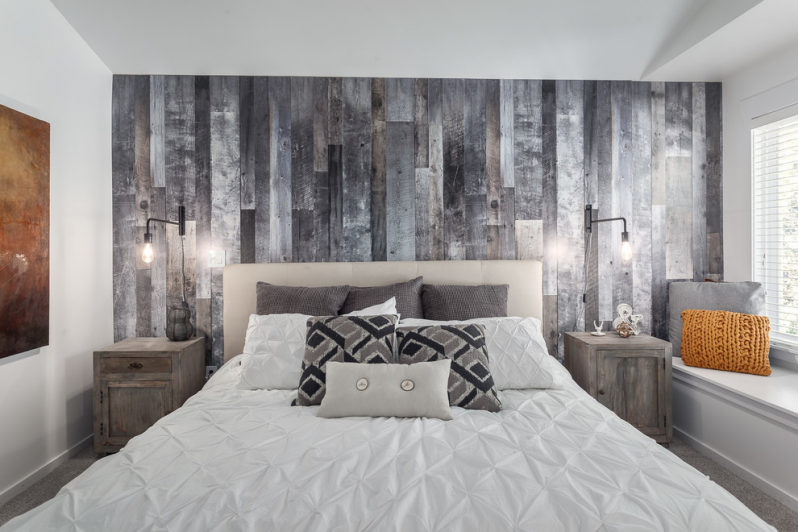
It is the laminate on the wall of the hallway in the interior that is most often placed in this way, and this is clearly seen in numerous photos. Usually this room is rarely large enough and bright, and due to this technique, these shortcomings can be well compensated.
If you are a supporter of the most unexpected approaches to decorating, mark the canvases diagonally.
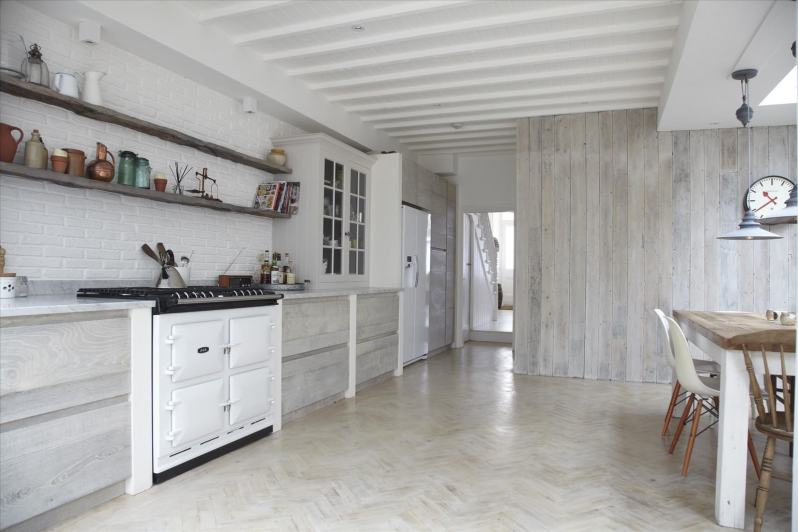
This format is suitable for both spacious and tiny spaces. The main thing is that the lamellas themselves are the same in width.
You can also use the type of design, popularly referred to as the "herringbone". You need to be very careful with it, as it can make your room look a bit old fashioned.
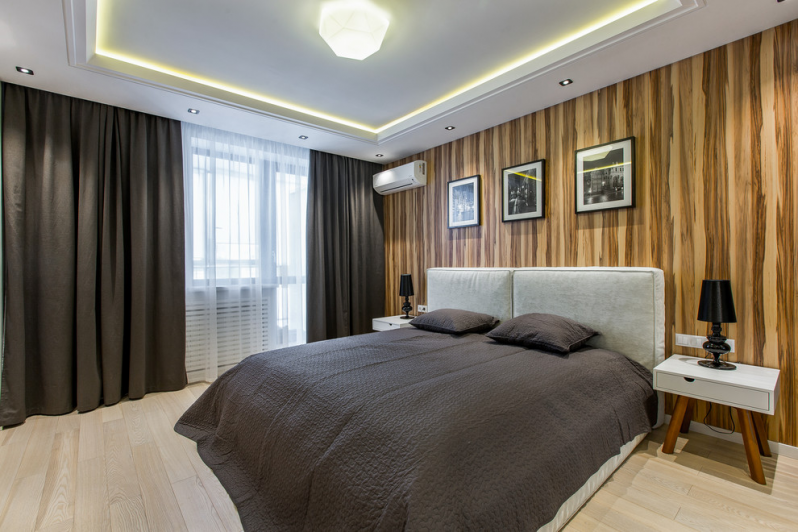
To prevent this, the use of an extraordinary lamp mounted in the panel will allow. For example, in the form of a street lamp or an elongated tube.
How to use this technique in the bedroom?
Laminate can be used to fill the entire wall as a whole, and use it to highlight a separate area.
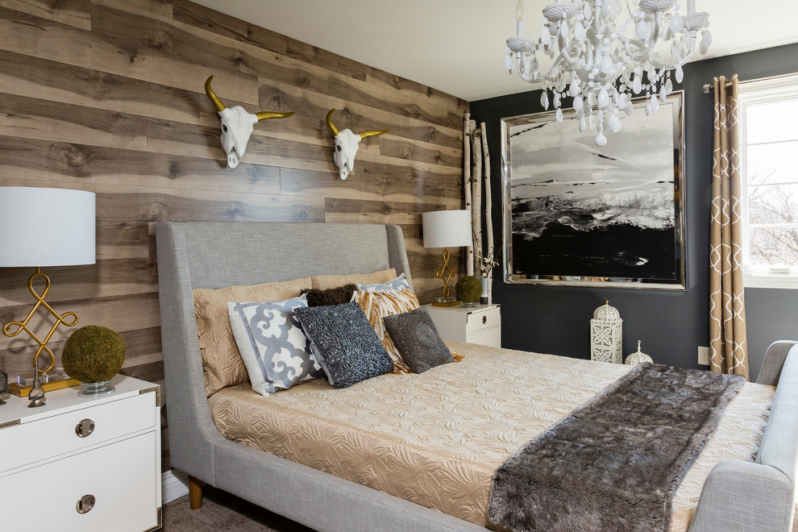
For example, replace the head of a massive bed with them or fill a niche for a library with open shelves with such boards.

In addition, you can make a catchy single composition by combining the design of both the floor and the walls with one material. This technique will erase the hard lines in the room, filling it with comfort and an atmosphere of home warmth.
For a youth bedroom, you can create an asymmetrical composition of laminate strips and car signs or posters. They can also be painted in juicy shades that will not hide the pattern of the tree.

For a romantic interior, you need to choose shades that are pleasing to the eye and are associated with relaxation: vanilla, light brown, pale gray, sand.
They will look as organic as possible, due to the absence of a strong shine on the surface of the canvases.
,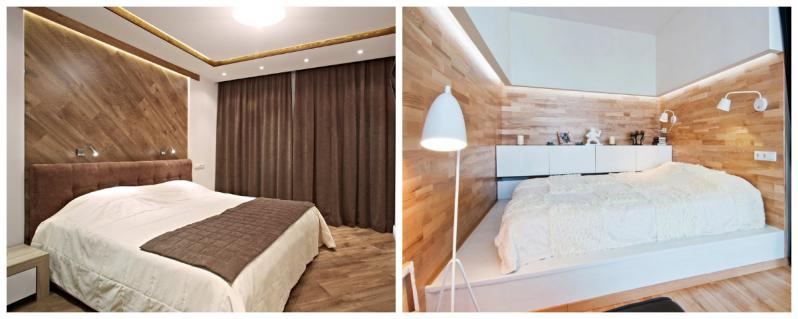
All kinds of shades of gray can be used to decorate the loft style. This color is considered the most "industrial" and will unobtrusively emphasize the overall solution, softening it a little due to the pronounced texture.
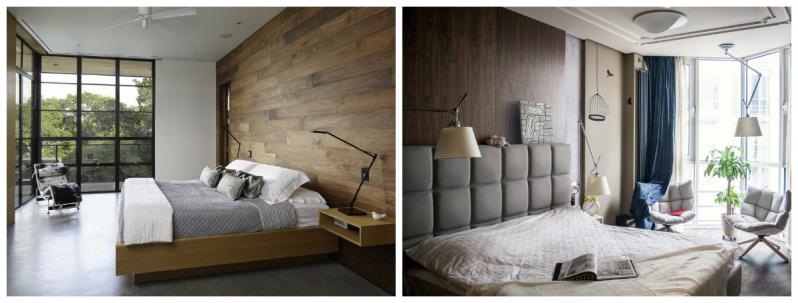
For the same interior, slightly aged, “worn” canvases, similar to pine and oak wood, will come in handy.
Is this material suitable for the kitchen?
This material looks amazing in a country-style kitchen, which is famous for its abundance of wooden furniture and textile accessories. It goes well with tiles, painted surfaces,.
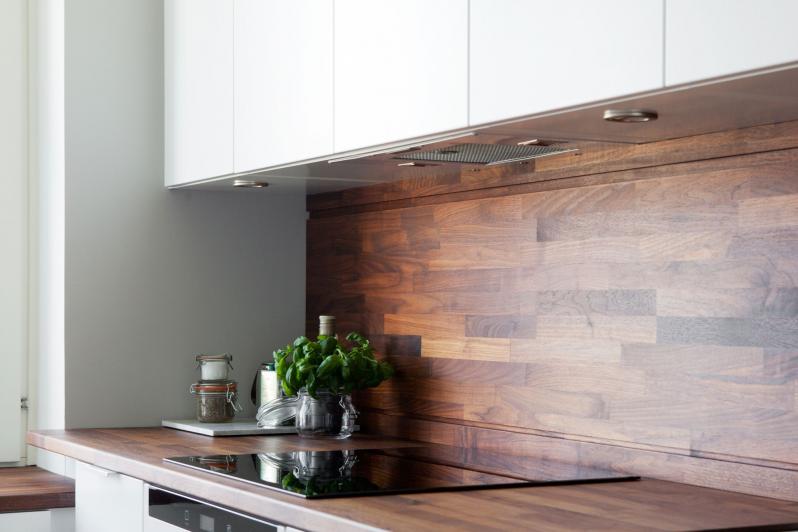
It can be placed as a frame for the fireplace or the wall on which the TV is placed. Laminate will look very cool, which goes well with furniture facades.
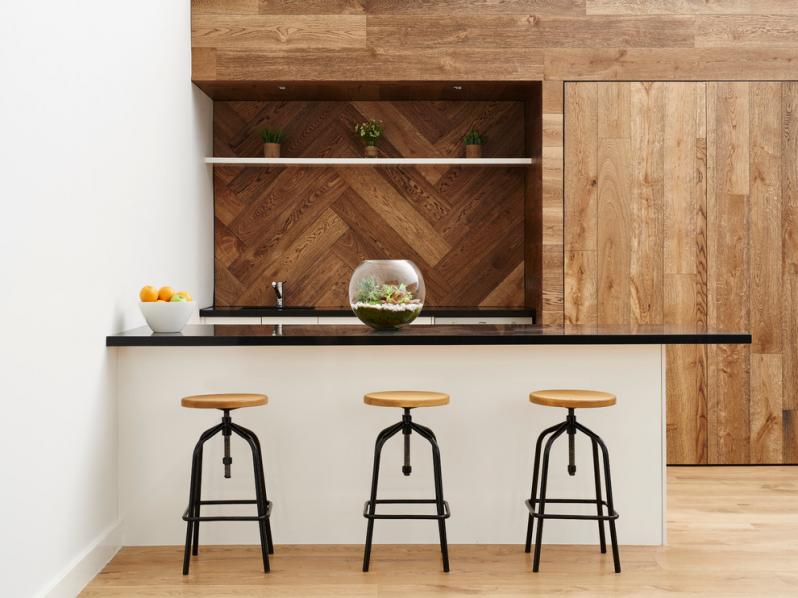

The laminate on the wall in the interior of the kitchen in the photo looks very impressive and aristocratic. However, we must not forget about the functional side of the issue.

Indeed, in order for it to remain attractive for a long time, it is necessary to take care of high-quality and regular care, as well as correct operating conditions. In this regard, it is better to place such profiles at a distance from hobs and ovens.

Laminate wall in the hall
Laminate is an excellent choice due to the variety of shades and textures available. It can be used both in "retro" rooms and in the most modern interiors. At the same time, he always looks appropriate and elegant.

With it, you can properly zone the space. Especially if it is multifunctional and serves both for relaxation and for receiving guests.

Due to the size of the room, you can afford to decorate it, thus, two walls - entirely or only at the junction (in the corner).
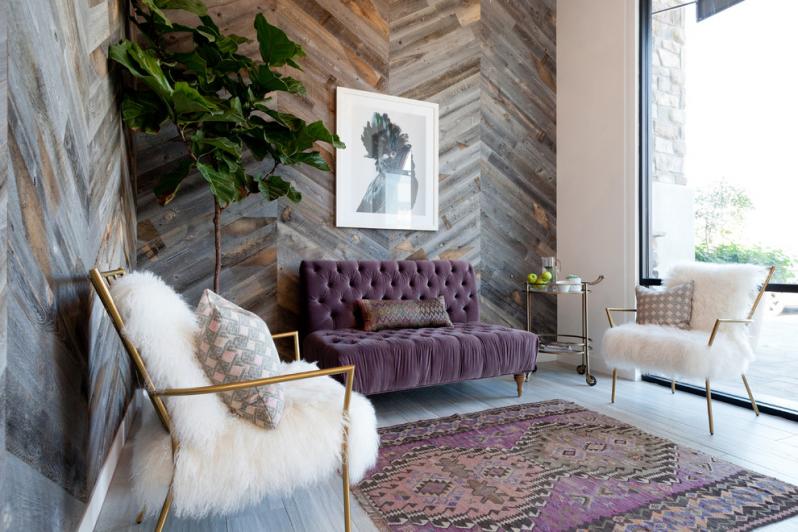
On the profiles themselves, you can place several shelves with vases, books and other decorations. Colorful details look charming on a smooth background of a natural shade.
In the hall, you can use the so-called patterned laying of the laminate. It will allow you to create a unique pattern that diversifies the simplest room.

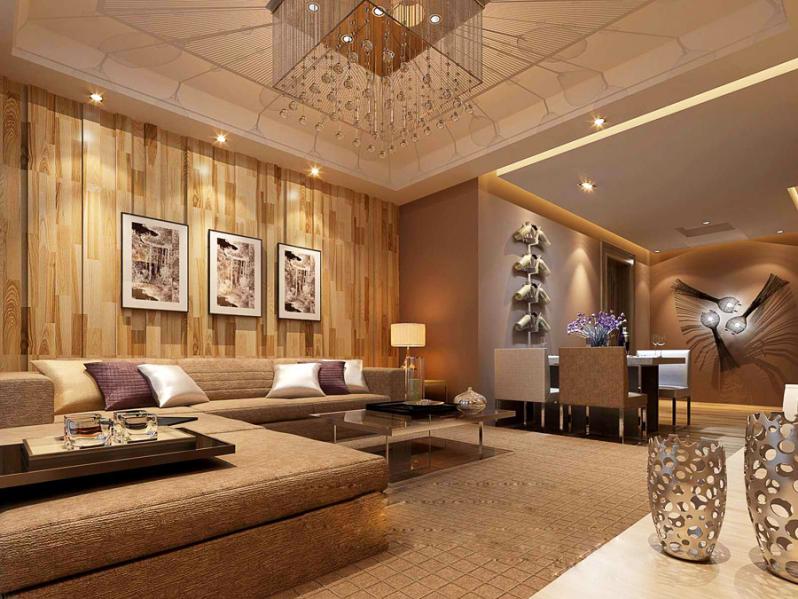
Although this can be argued, because eclecticism does not lose its relevance. And the combination of "incongruous" is still a fashionable and interesting solution.
We decorate the balcony
Of course, a laminate board can be used in this part of the house if it is heated and is a full-fledged part of the interior. Here you can place a small study, a reading place with a huge armchair or even a dressing room.
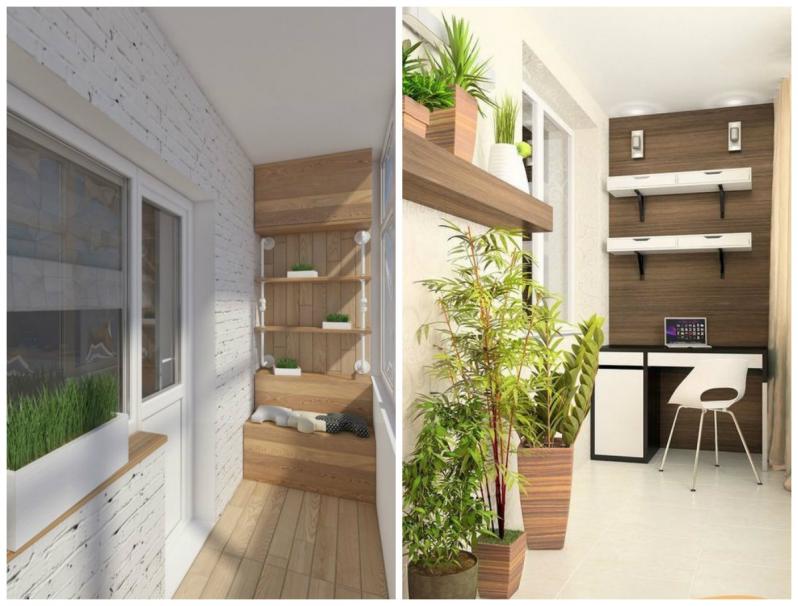
It is worth noting that, since such a coating resembles natural wood in terms of appearance, then it can be used in those stylistic solutions that are characterized by the use of natural details.


The texture of the pattern on the profiles can be small, barely noticeable. It can be very pronounced and even rude. This can play into your hands if you want to get a cozy and quiet corner to relax from the daily hustle and bustle.
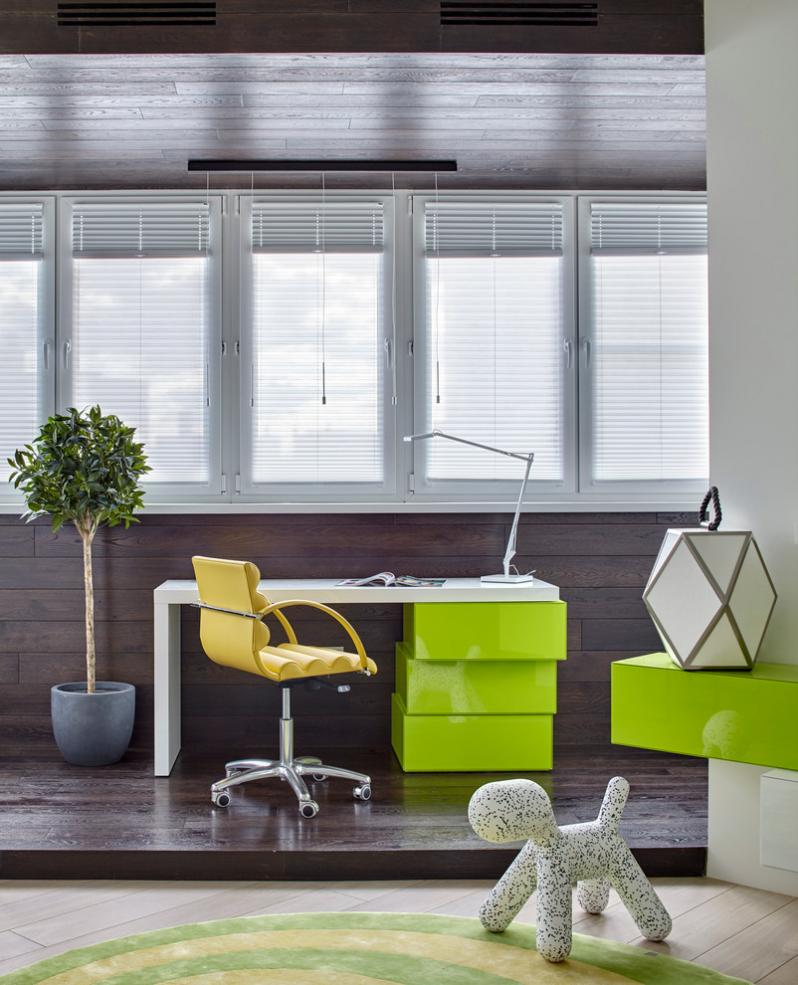
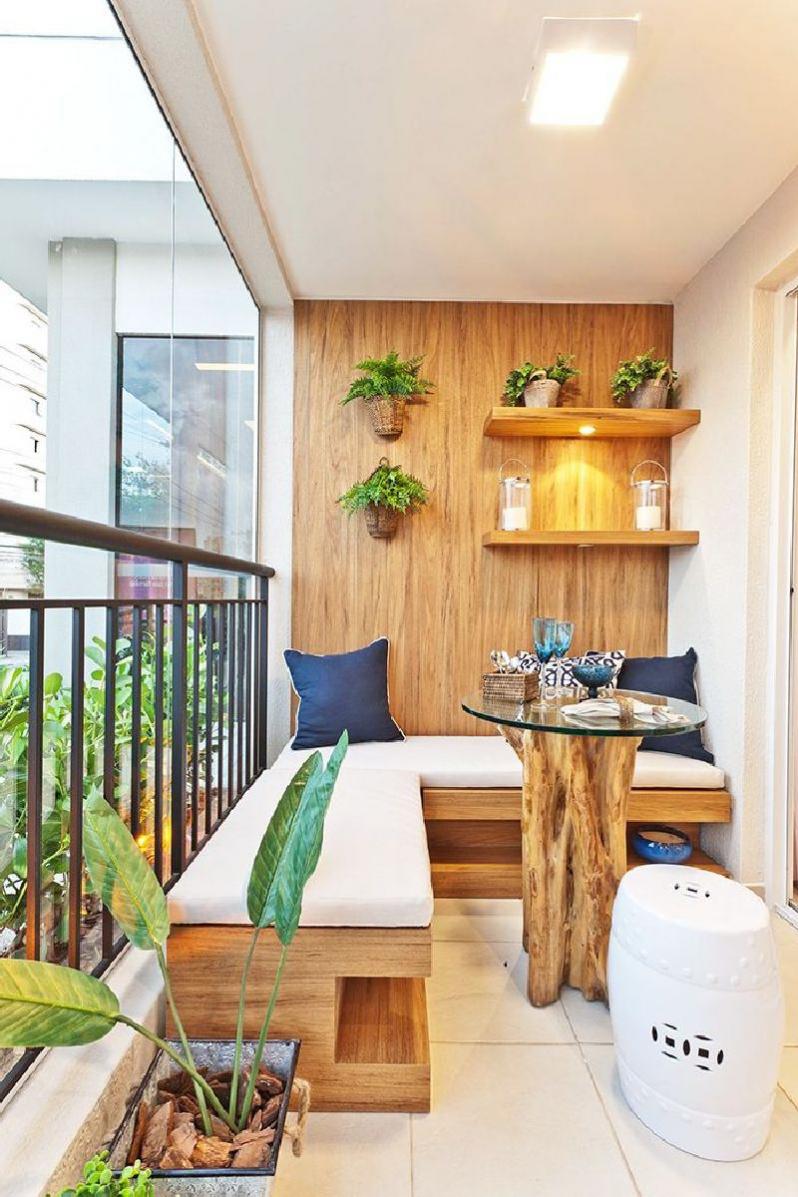
Not the last role in the use of this type of material for the design of the balcony is played by the fact that it serves as an additional heat-insulating layer.
What type of laminate should be preferred?
In general, speaking about this coating, one cannot fail to note its durability. Just imagine, if the laminate is designed for the floor, and without consequences can withstand considerable mechanical stress, how long can it last while on the wall?
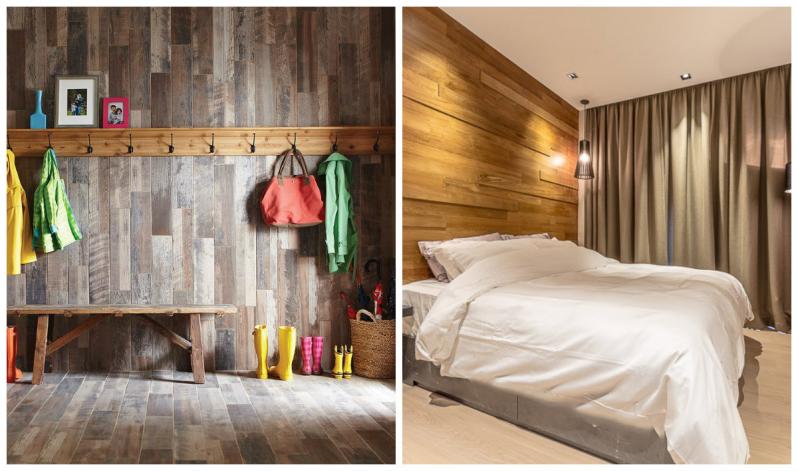
There are such classes of laminate boards:
- 33 - characterized by increased wear resistance, does not lose its characteristics after prolonged contact with water. It is better to use it for decorating rooms with unstable temperature conditions and an unfavorable climate - on the balcony, in the hallway or corridor;
- Classes 32 and 31 are perfectly protected from scratches and other damage, they can be used even if there are animals in the apartment, and at the same time not be afraid for its safety and integrity;
- Classes 23-21 are installed exclusively in warm, well-ventilated rooms, they do not like sudden changes in temperature and high humidity, they are considered the best option for a bedroom or living room.
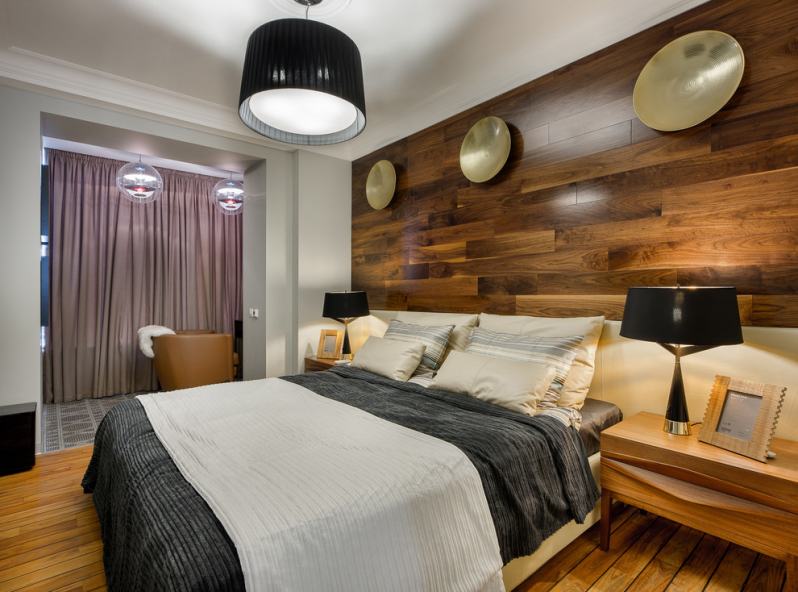
You can use the most inexpensive laminate without a doubt, and it will last you a long time. It is optimal if its thickness does not exceed 5-7 millimeters, so as not to hide the area of \u200b\u200bthe room in any way.
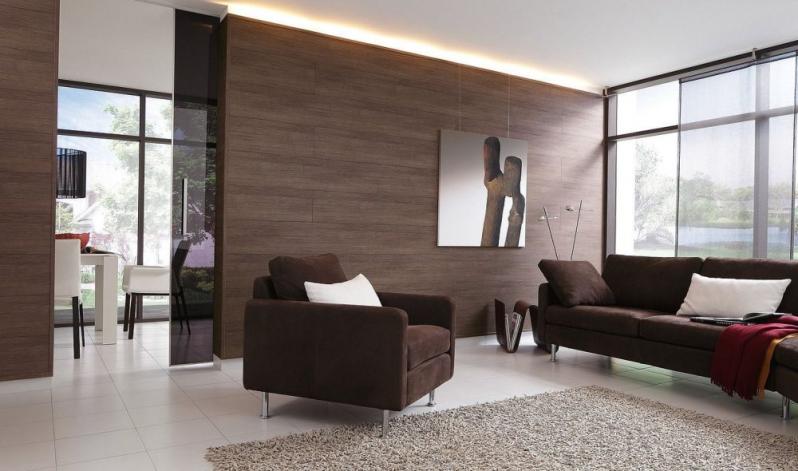
Many manufacturers have taken into account the popularity of using laminate for wall decoration and have released separate series specifically for this purpose. They are equipped with an easy-to-install fastening, and have all the necessary features to extend the service life.
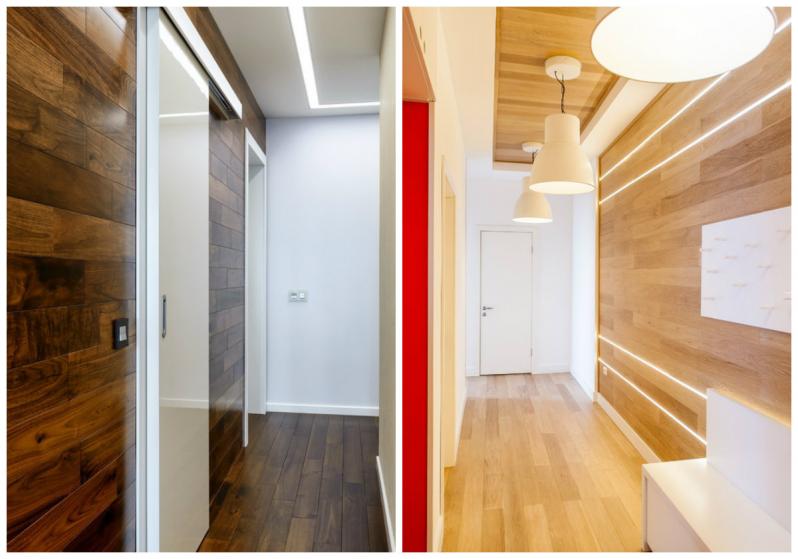

Any laminate on the wall in the interior and in the photo, and in Everyday life looks nontrivial. This solution allows you to expand the scope, and get a truly unconventional and fashionable room.
Mounting Features
The installation process of this material is simple. If necessary, you can perform it yourself, without preliminary preparatory work.
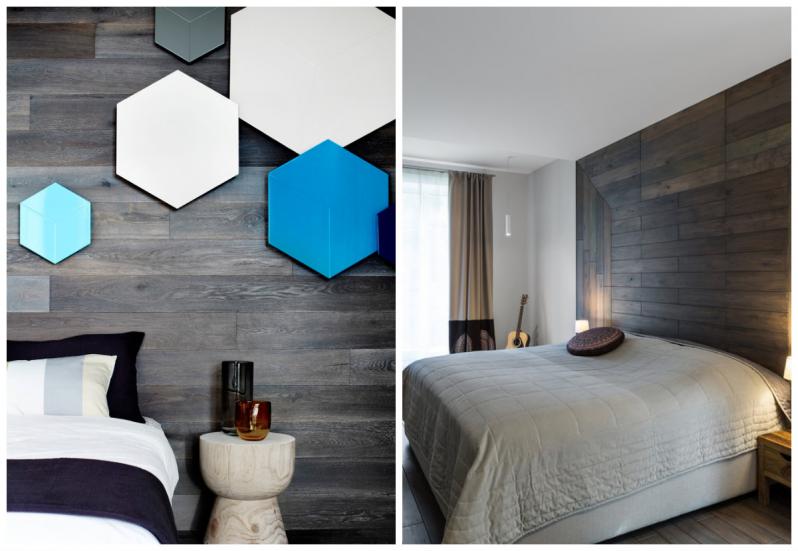
By the way, another "plus" in its use can be considered the fact that it perfectly levels the surface and hides the existing defects. For example, cracks, protruding wires and other communications.
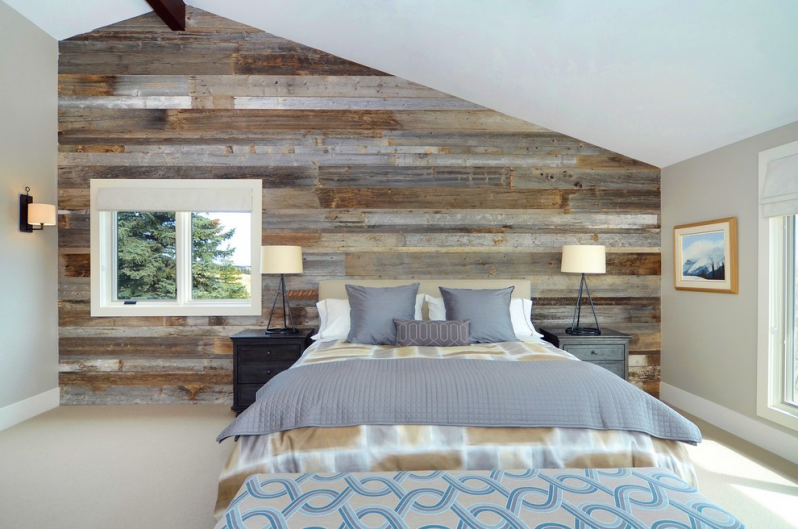
Direct mounting In this case, it can be done in several ways:

Speaking of myself panel laying technology, we can distinguish the following stages of work:

At the same time, one must not forget that laminate - heavy in weight. Therefore, its adhesion to other material must be strong and carefully considered.
Indeed, if it is illiterate to place it on a plasterboard wall, it may not withstand such a load. The same applies to surfaces covered with ordinary plaster mortar.

In any case, the important thing is that using this flooring not quite for its intended purpose, you can significantly transform your home. Turn it into an authentic and very stylish space.
Unexpected experiments often lead to unique and original results. Allow yourself to live not by the rules, and you will definitely like it.




















